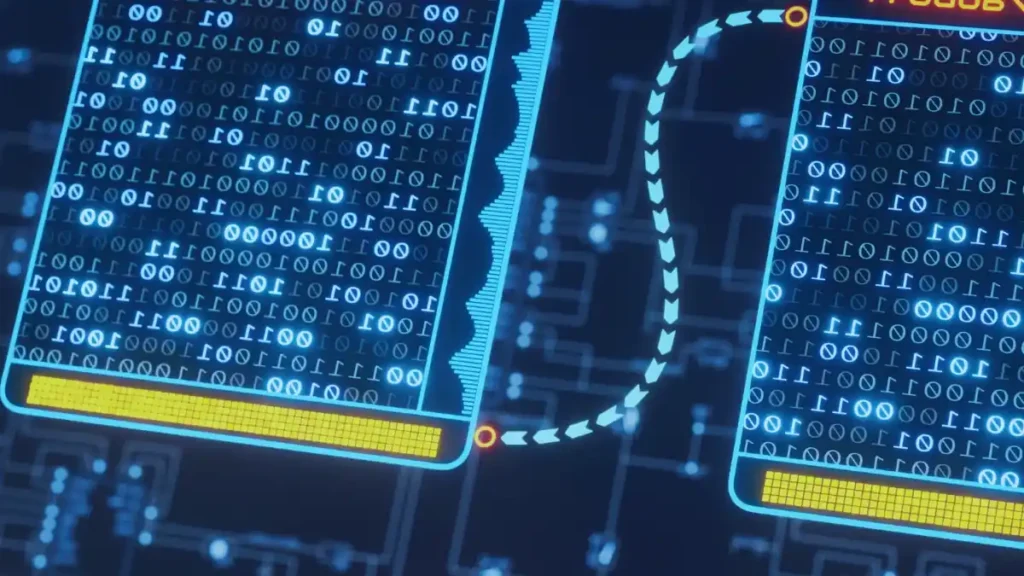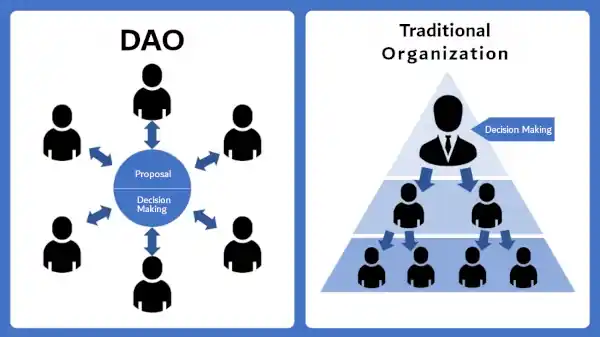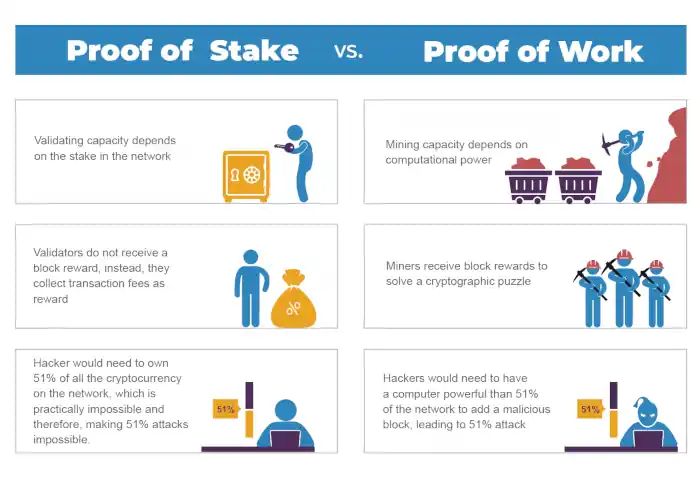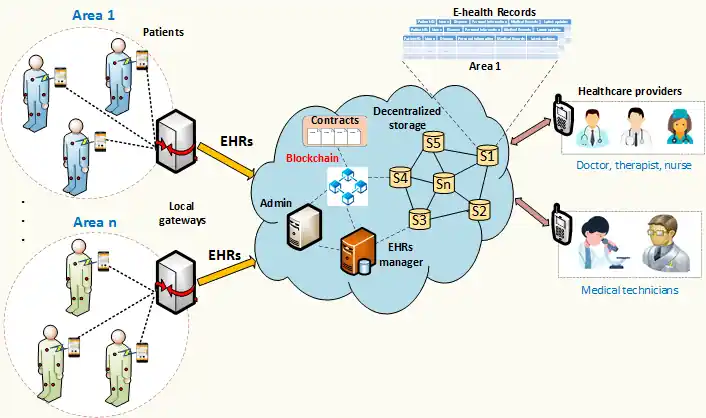Imagine a world where trust is guaranteed, transactions are transparent, and tampering is virtually impossible. Welcome to the world of blockchain technology. At its core, blockchain serves as a secure, transparent, and decentralized ledger for transactions.
Unlike traditional databases, blockchain records are immutable and self-regulated, offering a groundbreaking way to facilitate interactions without the need for intermediaries. Intrigued? Keep reading to discover how blockchain is set to become a cornerstone of our digital lives, shaping economies, and fostering trust on a global scale.
In this article:
- What is Blockchain Technology?
- How Does Blockchain Work?
- Types of Blockchain
- Use Cases
- Benefits of Blockchain
- Challenges and Concerns
- Impact on Humanity
- Future Prospects
- Conclusion
- References
- Further Reading

1. What is Blockchain Technology?
In the realm of digital technology, few innovations have captured the collective imagination as profoundly as blockchain. While it often finds itself in the same conversations as cryptocurrencies like Bitcoin, blockchain’s potential applications and implications extend far beyond the realm of digital currency. At its most basic level, a blockchain is a distributed, immutable ledger for recording transactions, data, or any other digital event. But let’s break that down a little further.
The Immutable Ledger
In traditional databases, administrators have the power to alter or delete records. In stark contrast, once data is added to a blockchain, it is extremely difficult to change. This feature is known as ‘immutability’, and it is ensured through complex cryptographic algorithms. Every record on a blockchain is timestamped and linked to the preceding entry, creating a chain of irreversible events. This quality builds an inherent layer of trust, as users can be confident that once something is recorded on a blockchain, it cannot be tampered with easily.
Distributed and Decentralized
While traditional databases often reside on centralized servers controlled by a single entity, blockchains are typically distributed across multiple nodes or computers. This decentralization enhances the security of the blockchain; to alter any record, a malicious actor would need to compromise more than half of the participating nodes—a feat increasingly difficult as the number of nodes grows.
Transparency with Privacy
Another differentiator is transparency. In public blockchains, anyone can view the entire transaction history, providing a level of transparency not often seen in traditional databases. However, while the transaction history is public, the parties involved in transactions can remain anonymous, protected by cryptographic pseudonyms.
Beyond a Database
At this point, you may wonder how blockchain goes beyond being a ‘super-secure database.’ Firstly, the decentralized nature of blockchain allows for the removal of intermediaries in many traditional processes. Whether it’s banks in financial transactions or notaries in validation of documents, blockchain has the potential to render many traditional ‘middlemen’ obsolete.
Secondly, smart contracts—self-executing contracts with codes directly written onto the blockchain—allow transactions and other complex tasks to be automated, setting predefined conditions under which various actions will be executed. This capability opens up an array of use-cases ranging from automated supply chain management to decentralized autonomous organizations (DAOs).

Lastly, the blockchain ecosystem is a fertile ground for innovations like Non-Fungible Tokens (NFTs), decentralized finance (DeFi), and more. These new concepts are redefining how we view assets, governance, and equity—demonstrating that blockchain is not merely a storage mechanism but a foundational technology capable of altering the fabric of society itself.
Why It Matters
The amalgamation of immutability, decentralization, and transparency makes blockchain technology a potential game-changer in digital trust. It has the capability to redefine transactions, eliminate intermediaries, and provide an unprecedented level of security and transparency—transforming not just businesses and governance, but societal structures at large.
By diving into the mechanisms, types, and implications of blockchain in the following sections, we’ll see how this technology is setting the stage for a new era of trust, collaboration, and digital interaction across the globe.
In summary, while a blockchain can function as a database, its benefits of security, decentralization, and transparency make it much more than just a safe place to store information. As we delve deeper into its workings, you’ll discover that blockchain is not merely a technological revolution; it’s an ideological paradigm shift.
2. How Does Blockchain Work?
Understanding how blockchain works requires delving into its architectural intricacies. The technology employs a blend of cryptography, distributed computing, and consensus algorithms to achieve its hallmark features of immutability, transparency, and decentralization. Let’s break down these core components to gain a better grasp of the mechanisms that power blockchain technology.
Blocks and Chains
The term “blockchain” is quite literal: it’s a chain of blocks. Each block serves as a container for a list of transactions or data entries. When a block reaches a predetermined size or time limit, it is sealed and linked to the previous block in the chain, forming a chronological sequence.
Every block contains a header and a body. The header comprises metadata like a timestamp, a link to the previous block (usually through a cryptographic hash), and the solution to a complex mathematical problem. The body contains the transaction data or the information being stored.
The chaining of blocks ensures that older transactions cannot be altered without modifying all subsequent blocks, which would require immense computational power and make the act noticeable to all participants.
Hash Functions
Hash functions play a critical role in maintaining the integrity and security of a blockchain. A hash function takes an input and produces a fixed-size string of characters, which is typically a digest representing the data. Importantly, hash functions are one-way operations. Given a hash output, it is computationally infeasible to reverse it to obtain the original input.
Each block’s header contains the hash of the previous block’s header, creating a cryptographic link between blocks. This is essential for ensuring the immutability of past transactions. If an attacker attempts to alter the information in a block, the hash of that block will change, thereby breaking the cryptographic link with subsequent blocks in the chain. To re-establish the chain, the attacker would need to re-calculate the hash for every subsequent block—a task that is virtually impossible in a robust blockchain network.
Nodes and Network
In a blockchain, nodes are the individual computers that participate in the network. Each node maintains a copy of the blockchain, thus contributing to the system’s decentralization. Nodes fall into various categories based on their functions:
- Full Nodes: Store the complete version of the blockchain and validate all transactions and blocks.
- Miner Nodes: Specialized nodes that solve complex mathematical problems to validate transactions and create new blocks (more relevant in blockchains using a Proof of Work consensus algorithm).
- Light Nodes: Store only a subset of the blockchain, relying on Full Nodes for transaction validation and other tasks.
The network of nodes ensures that no single entity controls the blockchain, enhancing its resistance to censorship, downtime, and tampering.
Consensus Algorithms
A consensus algorithm is the mechanism by which a blockchain network agrees on the validity of transactions. Different blockchains use different consensus algorithms based on their specific needs and objectives. Here are two widely used algorithms:
- Proof of Work (PoW): This algorithm requires nodes (often called miners) to solve complex mathematical problems to validate transactions and create new blocks. Solving the problem requires substantial computational power, making it expensive and time-consuming to alter past transactions. This is the algorithm used by Bitcoin.
- Proof of Stake (PoS): In this system, validators (the equivalent of miners in PoW) are chosen to create new blocks based on the number of coins they hold and are willing to “stake” as collateral. This algorithm is generally faster and more energy-efficient than PoW. Ethereum, a leading blockchain platform, is transitioning from PoW to PoS.

These consensus algorithms serve to synchronize the distributed ledger across all nodes, ensuring that everyone has a consistent view of the data and that only valid transactions are added to the blockchain.
In summary, blockchain works through the interplay of its foundational elements: blocks hold the data, chains link the blocks, hash functions ensure integrity, nodes maintain a distributed network, and consensus algorithms enable network-wide agreement. Each component serves to uphold the principles of decentralization, transparency, and immutability, making blockchain a transformative force in the realm of digital transactions and beyond.
3. Types of Blockchain
Blockchain technology has evolved to accommodate a variety of needs and use-cases. Based on accessibility, validation methods, and who gets to participate in the network, blockchains can be categorized into several types. Understanding these variations is essential for comprehending how blockchain is applied in different scenarios.
Public Blockchains
Public blockchains are open-source and permissionless, meaning anyone can join the network, validate transactions, and create new blocks. These are the most decentralized form of blockchains and are fully transparent. Examples include Bitcoin and Ethereum.
Private Blockchains
Contrary to public blockchains, private blockchains are permissioned and often run by a single organization. Access to the network, transaction verification, and block creation are restricted to pre-approved participants. Private blockchains are useful in corporate settings where privacy and control are paramount but still offer more transparency and security than traditional databases.
Consortium Blockchains
A consortium blockchain is a middle-ground between public and private blockchains. In these systems, multiple organizations share the responsibility of maintaining the blockchain, validating transactions, and creating new blocks. Consortium blockchains are often used for business collaborations where multiple parties require access to the same data but still desire to keep that data secure from unauthorized entities.
Hybrid Blockchains
Hybrid blockchains combine features of both public and private blockchains. They allow for a controlled environment within a broader public setting, offering both transparency and control. This is particularly useful for businesses that need to record public transactions but also want to keep some information private.
4. Use Cases
Blockchain technology has the potential to revolutionize various sectors of the economy and governance. Its unique combination of security, transparency, and decentralization makes it an ideal solution for many kinds of applications beyond its initial use-case of cryptocurrency. Below are some notable examples.
Cryptocurrency (e.g., Bitcoin)
Bitcoin was the first and remains the most famous application of blockchain. It serves as a decentralized digital currency without a central bank or single administrator. Transactions are added to the blockchain, providing transparency and security. The use of a Proof of Work consensus algorithm ensures that no single entity can control the Bitcoin network. Its success has paved the way for numerous other cryptocurrencies, including Ethereum, which introduced smart contracts to the blockchain space.
Supply Chain Management
Blockchain can significantly enhance transparency and traceability in supply chains. By recording every transaction or movement on a blockchain, companies can improve accountability, reduce fraud, and streamline the supply process. For example, a food manufacturer could trace the origin of a contaminated product back to its source instantly, saving time and potentially lives.
Voting Systems
Traditional voting systems are plagued by issues ranging from voter fraud to low turnout. Blockchain can streamline the voting process, making it easier, faster, and more secure. Estonia has been experimenting with blockchain in their e-governance initiatives, including voting systems. The transparency of the blockchain can serve to eliminate fraud, and the convenience could encourage higher voter turnout.
Healthcare Records
Healthcare systems across the globe struggle with data silos, inaccessibility, and a lack of interoperability. Implementing a blockchain-based system for medical records can significantly improve data integrity, security, and sharing capabilities. Patients could have secure access to their medical history, and the transparent yet immutable nature of the technology could enhance both compliance and collaboration among healthcare providers.

Through its various types and diverse range of use-cases, blockchain technology proves its versatility and transformative potential. Whether it’s bringing financial autonomy to individuals via cryptocurrencies, enhancing transparency in supply chains, revolutionizing voting, or improving healthcare systems, blockchain is redefining how we think about transactions, data, and trust in the digital age.
5. Benefits of Blockchain
As blockchain technology continues to evolve and find applications beyond cryptocurrency, its intrinsic benefits become increasingly significant. These advantages range from enhanced security to unprecedented transparency and robust decentralization. Let’s delve into each of these attributes.
Security
Security is one of the most compelling features of blockchain technology. Traditional databases are vulnerable to attacks that can alter or delete data, but the cryptographic hashing and chaining in blockchain make it exceedingly difficult to alter existing information. Once data is written into a block and that block is added to the chain, changing that data would require altering every subsequent block, which is computationally impractical.
Moreover, the decentralized nature of the network adds another layer of security. Even if one or several nodes are compromised, the integrity of the blockchain remains intact because other nodes maintain correct copies. These features make blockchain a formidable technology for securing sensitive information and transactions.
Transparency
Transparency is a fundamental aspect of blockchain technology, achieved through its public ledger system. In a public blockchain, anyone can verify the transactions and audit the blockchain, ensuring a high level of accountability. Even in private or consortium blockchains, transparency is maintained among the pre-approved participants, facilitating trust and collaboration.
This level of transparency is especially beneficial in use-cases like supply chain management, where it’s crucial to trace the origin and journey of products. It also helps in regulatory compliance and audit trails, making it easier for organizations to adhere to guidelines and standards.
Decentralization
Unlike traditional databases that rely on a central authority, blockchains are inherently decentralized. This architecture empowers individuals and removes the need for intermediaries like banks or payment processors. Decentralization ensures that no single entity has control over the entire blockchain, making it resistant to censorship and single points of failure.
Decentralization also promotes innovation and inclusivity. For example, decentralized finance (DeFi) systems aim to offer financial services to people without access to traditional banking systems, using blockchain to ensure security and transparency.
6. Challenges and Concerns
While blockchain offers many advantages, it is not without its challenges and concerns. From scalability issues to significant energy consumption and regulatory hurdles, there are obstacles that the technology must overcome to reach its full potential.
Scalability
One of the major challenges facing blockchain is scalability. As the number of transactions on a blockchain increases, the system can become slower and more expensive to use. This is particularly an issue for public blockchains like Bitcoin and Ethereum, where every transaction must be verified by multiple nodes.
Several solutions have been proposed to address this issue, including layer 2 solutions like Lightning Network for Bitcoin and sharding for Ethereum. However, scalability remains an area that requires ongoing research and development.
Energy Consumption
Blockchain networks, especially those using Proof of Work (PoW) consensus algorithms, are often criticized for their high energy consumption. The computational power required to maintain these networks can be substantial, leading to concerns about their environmental impact.
Newer consensus algorithms like Proof of Stake (PoS) are being developed to address this concern. Ethereum’s planned transition to a PoS algorithm aims to significantly reduce its energy consumption, setting a precedent for more sustainable blockchain systems.
Regulatory Hurdles
The decentralized and borderless nature of blockchain poses challenges for regulatory frameworks. Governments are still figuring out how to tax cryptocurrency transactions, ensure compliance, and prevent illegal activities facilitated through blockchain. Regulatory uncertainty can hinder the adoption of blockchain technology, especially in industries that are heavily regulated like finance and healthcare.
In summary, blockchain technology presents a wide array of benefits that make it attractive for many applications, but it also faces significant challenges that need to be addressed. Its unparalleled security, transparency, and decentralization are powerful advantages, yet scalability, energy consumption, and regulatory hurdles remain obstacles to its widespread adoption. As research and development continue, it’s likely that solutions to these challenges will emerge, allowing blockchain technology to realize its transformative potential fully.
7. Impact on Humanity
As we navigate through the digital age, blockchain technology stands out as a disruptive innovation with the potential to radically transform a variety of sectors. It goes beyond just financial applications to touch upon areas as diverse as governance, healthcare, and even interpersonal trust at a global scale.
How It Can Revolutionize Various Sectors
Blockchain has applications in fields far removed from its origins in digital currency. For example, in healthcare, it can secure patient records while making them easily accessible, enabling timely and effective treatment. In supply chain management, blockchain can authenticate each step of the product journey, increasing trust and reducing fraud.
Similarly, blockchain can revolutionize governance and civil systems. Voting, a cornerstone of democracy, can be dramatically improved in both security and accessibility through blockchain technology. Land records, often a subject of disputes, can be securely and transparently managed on a blockchain.
Moreover, blockchain can enable the concept of “smart cities,” where urban management is highly optimized and automated, thanks to transparent yet secure data sharing. From energy grids that respond dynamically to usage patterns, to waste management systems that operate at peak efficiency, the applications are limitless.

Its Potential to Foster Global Trust and Cooperation
Blockchain’s inherent transparency and security can serve as a foundation for global trust and cooperation. As records and transactions become more transparent yet secure, a new kind of confidence can emerge between nations, corporations, and individuals.
International trade could be streamlined with fewer bureaucratic hurdles, reducing costs and increasing efficiency. Global initiatives, like climate change agreements or humanitarian aid, can be tracked more accurately, ensuring that resources are appropriately used.
In a world often marred by data breaches and trust issues, blockchain offers a way forward to reclaim transparency and trustworthiness as default values in global interactions.
8. Future Prospects
As with any emerging technology, the future prospects of blockchain technology are subject to ongoing research and the rate of adaptation. Both of these factors will significantly determine the technology’s ultimate impact and its development trajectory.
Ongoing Research
While blockchain has shown immense promise, it’s still a subject of extensive research. Scalability is a major focus, with layer 2 solutions and alternative consensus algorithms being actively explored. Security enhancements, better user interfaces, and methods to reduce energy consumption are other avenues where research is ongoing.
Emerging fields like quantum computing present both a challenge and an opportunity for blockchain. Quantum computers, once they become sufficiently advanced, could potentially break current cryptographic methods, but they could also lead to new, more secure cryptographic techniques suitable for blockchain.
Adaptation Rates
The rate at which different sectors adapt to blockchain technology varies considerably. Financial sectors and supply chain management are among the early adopters, but other sectors like healthcare and governance are proceeding more cautiously, often due to regulatory concerns. (Read: The Evolution of Currency to Cryptocurrency)
Public awareness and understanding of the technology are also vital for its widespread adaptation. As blockchain becomes more user-friendly and accessible, it’s likely that we’ll see an accelerated rate of adoption across multiple sectors.
The integration of blockchain into existing systems is another critical factor. For instance, the more easily blockchain can be implemented into current healthcare records systems or supply chain databases, the quicker those sectors can benefit from its advantages.
In conclusion, the impact of blockchain on humanity could be profound. It has the potential to revolutionize various sectors, fostering a new era of global trust and cooperation. With ongoing research surmounting current challenges and adaptation rates increasing, the future of blockchain technology is incredibly promising. As we move forward, it holds the promise not just of technological innovation but also of a more transparent, secure, and cooperative global community.
9. Conclusion
In the journey through this comprehensive guide, we’ve explored blockchain’s nuanced architecture, its various types and use-cases, the benefits and challenges it brings, and its profound potential impact on various sectors and humanity as a whole.
Blockchain is revolutionary not just in its technical ingenuity but in its ability to redefine trust and transparency in the digital age. It offers an unparalleled blend of security, transparency, and decentralization that could revolutionize everything from healthcare and finance to governance and international cooperation.
As with any technology, challenges exist, but they are not insurmountable. As research progresses and adoption rates rise, blockchain technology has the potential to be a cornerstone for future innovations. Its ability to foster global trust and cooperation is particularly compelling in our increasingly interconnected world.
We stand at the cusp of a new era. The blockchain revolution isn’t just coming; it’s already here, quietly laying the groundwork for a future that’s more transparent, secure, and equitable.
10. References
- Nakamoto, S. (2008). Bitcoin: A Peer-to-Peer Electronic Cash System.
- Mearian, L. (2019). What is blockchain? The complete guide. Computerworld.
- Tapscott, D., & Tapscott, A. (2016). Blockchain Revolution: How the Technology Behind Bitcoin Is Changing Money, Business, and the World.
- Mougayar, W. (2016). The Business Blockchain: Promise, Practice, and Application of the Next Internet Technology.
- Hyperledger Project. (n.d.). Retrieved from https://www.hyperledger.org/
- Ethereum Foundation. (n.d.). Retrieved from https://ethereum.org/
- Blockchain for Secure EHRs Sharing of Mobile Cloud Based E-Health Systems (Health Records Figure)
11. Further Reading
For those keen on diving deeper into the world of blockchain technology, the following books are highly recommended:
- “Blockchain Basics: A Non-Technical Introduction in 25 Steps” by Daniel Drescher. Perfect for those new to blockchain who want a clear and simple understanding.
- “Blockchain Revolution: How the Technology Behind Bitcoin and Other Cryptocurrencies is Changing the World” by Don Tapscott and Alex Tapscott. A comprehensive look at how blockchain can disrupt various industries.
- “The Basics of Bitcoins and Blockchains” by Antony Lewis. A great resource for understanding the financial aspects and implications of blockchain and cryptocurrencies.
- “Mastering Blockchain: Unlocking the Power of Cryptocurrencies, Smart Contracts, and Decentralized Applications” by Imran Bashir. A more technical deep-dive into the mechanisms that make blockchain work.
- “Cryptoassets: The Innovative Investor’s Guide to Bitcoin and Beyond” by Chris Burniske and Jack Tatar. For those interested in the investment potential of blockchain and related technologies.
These books offer a mix of introductory, comprehensive, and specialized perspectives, and they are excellent starting points for anyone looking to understand blockchain technology better.